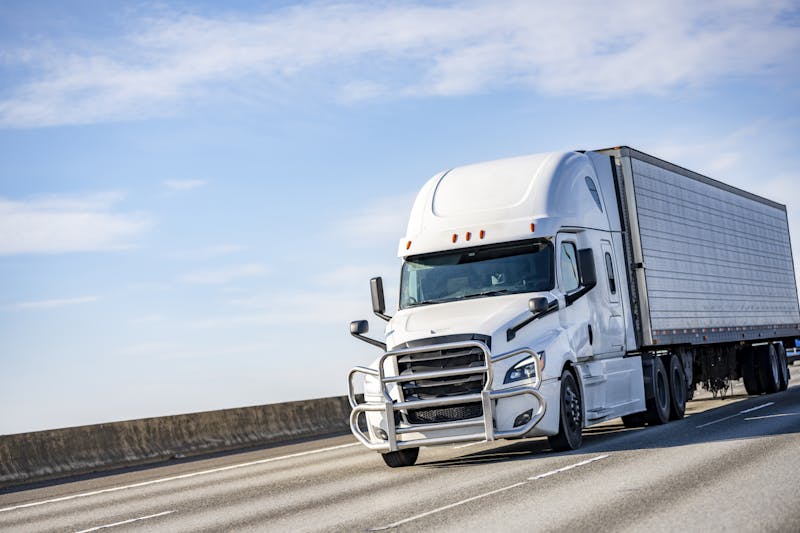Contact Us
Complete the form below for a free case evaluation.

Driving near large trucks is a reality for everyone on the road. Whether commuting to work, traveling on the interstate, or driving through your neighborhood, you'll likely encounter tractor-trailers and other commercial vehicles regularly. While most truck drivers are well-trained professionals, the sheer size and weight of these vehicles can make even a minor mistake deadly.
At Webster Vicknair Macleod, we’ve seen firsthand the devastation caused by preventable truck accidents. Those who share the road with trucks should be aware of various safety tips, the unique challenges of sharing the road with trucks, and how simple precautions can help reduce the risk of serious collisions.
Truck accidents differ from standard car crashes due to the physical disparity between vehicles. A fully loaded semi-truck can weigh up to 80,000 pounds—20 to 30 times more than the average car. This difference affects everything from stopping distance to maneuverability.
Truck accidents often result in:
Even low-speed crashes involving trucks can have serious consequences, especially when a smaller vehicle is trapped beneath or crushed by a trailer.
Understanding what causes truck accidents can help drivers take steps to prevent them. While truck drivers can and do make mistakes, crashes are often the result of interaction between both parties.
Some of the most common causes of truck accidents include:
While truck drivers have a legal duty to drive safely, other road users also play an essential role in preventing accidents.
To reduce the risk of a collision, drivers must adjust how they interact with commercial vehicles. Here are key tips for staying safe around big rigs:
Large trucks have significant blind zones—often called “No Zones”—on all four sides. If you can't see the truck driver's face in their side mirror, assume they also can't see you.
Trucks need more room to stop and maneuver. Cutting in front of a truck can eliminate its braking cushion, putting everyone in danger.
Merging too closely in front of a truck is a risky maneuver. Trucks cannot react as quickly as smaller vehicles.
Trucks often swing wide—sometimes using two lanes—to make a right turn.
Following a truck too closely reduces your visibility and increases the risk of rear-end collisions.
Erratic driving—such as weaving in and out of lanes or making abrupt stops—can confuse other drivers, especially those operating large trucks.
Speeding increases stopping distance and reaction time.
If you see a truck driver swerving, tailgating, speeding excessively, or engaging in any reckless behavior, do not hesitate to call local law enforcement.
Being proactive not only protects you but could save lives.
Driving near trucks at night or on highways presents additional risks. Visibility is lower, and fatigue is more common among drivers.
Despite your best efforts, truck accidents can still happen. If you are involved in a collision:
Due to the commercial nature of trucking operations, accident claims can be particularly complex and challenging. There may be multiple layers of insurance and liability. That’s why consulting with a law firm that understands the trucking industry and personal injury law is essential.
Truck accidents often involve:
Truck drivers are trained to operate their vehicles with care, but they can’t control how others behave on the road. Every driver has a role to play in preventing truck accidents. By being aware of blind spots, giving trucks plenty of space, and driving defensively, you significantly reduce the risk of a devastating crash.
Small changes in driving behavior can significantly impact safety. If an accident does happen, knowing your rights and having legal representation can help protect your future.
At Webster Vicknair Macleod, we help truck accident victims investigate what went wrong, identify every liable party, and pursue fair compensation. If you or a loved one has been hurt in a commercial truck collision, contact us online today to schedule your free consultation.
Federal Motor Carrier Safety Administration. (n.d.-a). Driving safely around commercial motor vehicles [PDF]. U.S. Department of Transportation. https://www.fmcsa.dot.gov/sites/fmcsa.dot.gov/files/docs/ourroads/80251/driving-safely-around-cmvs.pdf
Federal Motor Carrier Safety Administration. (n.d.-b). Regulations. U.S. Department of Transportation. https://www.fmcsa.dot.gov/regulations/
National Highway Traffic Safety Administration. (n.d.). Event data recorder. U.S. Department of Transportation. https://www.nhtsa.gov/research-data/event-data-recorder
Complete the form below for a free case evaluation.
© Webster Vicknair Macleod. All Rights Reserved.